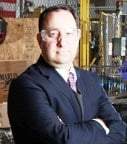Over the years, the Marlin Steel team has evolved. Back in the ‘90s, when Drew Greenblatt first acquired the company, we were a simple commodity manufacturer of wire baskets. Today, we are a highly advanced manufacturer of products that require extreme precision.
Where we once dealt primarily with bagel shops who products could handle a margin of error that was over an inch, we now make parts and products for industries that require accuracy to 1/4000 of an inch or less. A large part of this transformation was in our investment into automation, to be sure. However, it is our investment in our employees that has truly helped Marlin Steel rise above the challenges posed by cheap foreign labor and the ever-changing manufacturing market.
Workers Turned Expert Engineers
When Drew Greenblatt made the decision to invest in automation in order to make Marlin Steel more competitive as a company, he knew that it would take more than simply bringing in a robotic arm or two to make a true difference in the company, he needed people who could run those robotic arms and other manufacturing equipment in order to make them work at peak efficiency.
After all, without guidance from a qualified engineer to tell the robot arms what to do, they would be little more than extraordinarily expensive paperweights. Drew needed qualified engineers to create CAD files and turn them into programs that the equipment could use to turn designs into real-world parts and products.
But where would Drew find the engineers he needed?
Simple, they were already working for him. When the time came to find new engineers to run Marlin Steel’s automated manufacturing equipment, Drew put his existing work force through specialized schooling instead of just hiring on new workers to replace the old ones.
Practical Knowledge and Training Combined
The investment in re-training his existing workforce was high, but it is one that ultimately paid off for Marlin Steel’s owner. With their years of experience in bending, shaping, and using metal in a variety of applications being paired with the expert knowledge and training earned in their technical schooling, Marlin Steel’s newly-minted engineers returned to the workforce with a level of experience and know-how that is incredibly hard to come by.
Not only can these highly-skilled workers operate our automated processes and perform maintenance on both the software and hardware as needed, they have the accumulated knowledge that comes with specialized training and years of real-world experience. Because of this, our engineers are able to answer a number of questions about your needs.
For example, one of our clients had a question about using stainless steel in their high-temperature process. When they had initially been designing their process, they expected to be annealing parts at a temperature of 1,600 °F. To match this temperature, they had chosen to use grade 330 Stainless Steel in order to gain a longer service life for each basket used in the process. However, they had also began testing their process at temperatures of 1,200 °F, and wanted to know if a different, less expensive alloy could be employed in their process at this temperature.
While a treatise on the properties of the different grades of stainless steel (and the variants of each of these grades) and how they react to different temperatures and pressure environments would be long enough to fill an entire book, the basic question of “what is the right temperature” for any given alloy is one that Marlin Steel’s engineers are familiar with.
This client’s question started a short back and forth conversation between our engineer and the client, as they discussed the longevity of different alloys in the customer’s specific process at the lower temperature. One of the key points that was made is that while grade 316 or even 304 stainless steel would work at 1,200 °F, there would be noticeably more scaling with those materials than with the grade 330 stainless steel.
Through the discussion, the client was able to come to a better-informed decision that balanced their short-term costs against the long-term needs of their process.
In the end, our automation allowed us to manufacture the custom wire baskets for the client to microscopic precision to fit their exacting needs quickly, but it was the knowledge and expertise of our engineers that lead to those baskets being the right fit and material to make them perfect.
Take Advantage of Our Knowledge and Experience
If you have a question about your order, or need technical help, the team of engineers at Marlin Steel is here to help you. Whether you want to know what the right temperature for grade 316 stainless steel is or whether you’re better off with a wire basket or a basket made from custom-cut sheet metal, our people have the knowledge to answer your questions. Contact us now so we can help you.

.gif)


